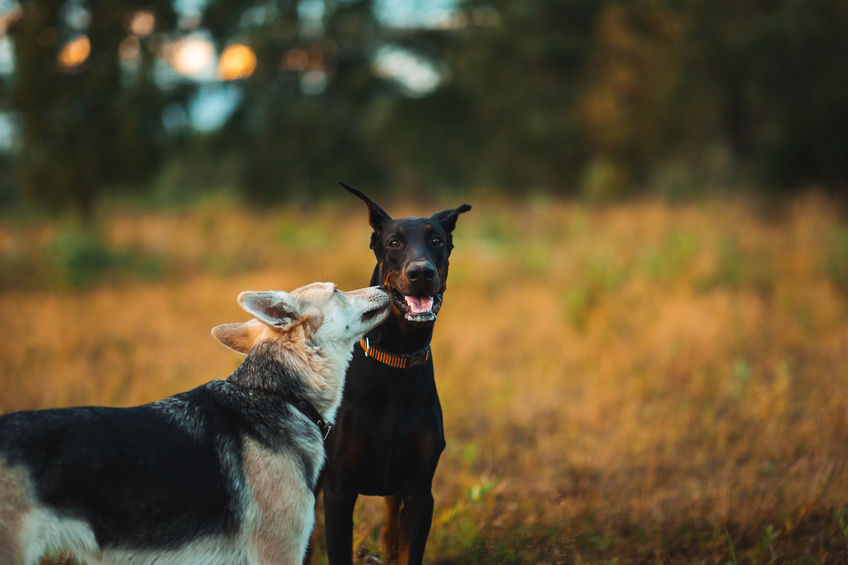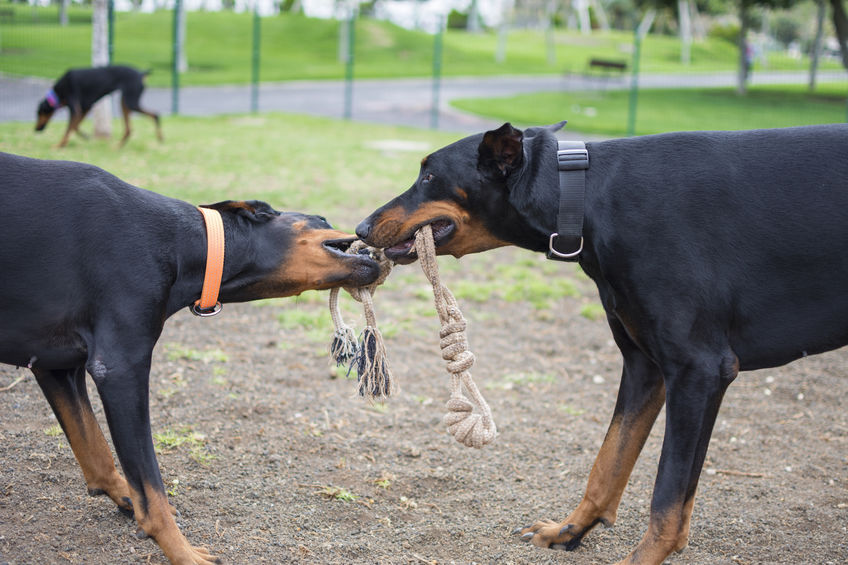
Do Dobermans do well with other dogs
In general, Dobermans are not known for being dog aggressive. With training and socialization, a Doberman is fine living and interacting with other dogs.
Every dog is an individual and there may be some Dobermans that don’t do well with other dogs. However, this is more likely the temperament of the individual Doberman and not a trait of the breed.
Sometimes male Dobermans may not do well with other male Dobermans or dogs. It is a natural instinct for a male Doberman to want to assert dominance in the household.
With good training and firm leadership, this does not need to the case. Generally, if you do have two Dobermans or a Dobe and another breed in the home it is better to get two females or opposite sexes.
Male Dobermans do seem to be more outgoing and playful by nature. So they are more likely to run off and play with new dogs than a female is.
Are Dobermans good with small dogs
A well trained and socialized Doberman is likely to get along fine with most small dogs. Dobermans are generally a friendly and gentle dog.
The main issue may occur if the small dog suffers from small dog syndrome. This is when a small dog thinks they are much bigger and tries to dominate a larger dog. Many of the Terrier breeds can fit into this category.
If you do want to have a Doberman and a small dog to live together, it is usually better if the small dog is the older one. Alternatively, if the Doberman and the small dog are raised together from puppies there are usually no problems.
It is also a good idea for the small dog to have a safe space they can go to. Alternatively, if the small dog seems overwhelmed or hassled by the Doberman it is best to separate them. This will avoid a situation where the small dog snaps or nips and the Doberman responds.
Dobermans as part of a multi-dog household
If you are considering having another dog and a Doberman in the same household, there are a couple of things to consider.
Get dogs of the opposite sex
Male Dobermans tend to be better with other dogs of the opposite sex. Therefore, if you have a male Doberman it is best to have a female as the other dog.
Female Dobermans generally are fine with other females or with a male dog.
Get dogs of different ages
Dogs in the same household that vary in age tend to get along much better. There is a clear hierarchy that becomes established. With dogs of the same or similar age, there can be some jostling for position in the pack.
I had three dogs at one time. They all varied in age and there were no issues at all. The social hierarchy sorted itself out with no interference from me. This is despite them all being males.
Generally, an age gap of two years or more is considered best.
Desex the males
Neutering a male dog stops any sexually motivated behavior. By neutering a male dog, it stops the production of testosterone preventing the desire to assert dominance over the other dogs.
Desexing obviously also prevents the male dog mating with the female resulting in unwanted puppies. It is also a good idea to spay the female also.
I don’t recommend desexing a dog until around 6 months old when they reach sexual maturity. Desexing stops the production of hormones. Studies have shown that these hormones are crucial in the development and growth of the dog. Dogs that are desexed too young are more prone to tendon and joint injuries later in life.
Be aware of food aggression
The most likely time for there to be an issue with two or more dogs is around food and mealtimes. There are two approaches you can take at mealtimes.
Either feed them separately in different areas or train both dogs to only eat from their own bowls. If you give your Doberman a bone to chew it is probably best to separate the dogs.
Other tips for having a Doberman in a multi-dog household are
- Ensure all your dogs receive the right amount of exercise and mental enrichment they require. Unreleased pent up energy can lead to fight or behavior issues. For a guide to Doberman exercise see here. If the other dogs in the household are of a different breed see here for a guide to their exercise needs.
- Supervise feeding time. Each dog should have their own bowl and not share. The dogs will quickly learn which is their bowl and understand the rules to mealtime.
- Ensure all the dogs receive equal attention and don’t have favorites. This will help to prevent any jealousy developing.
Doberman socialization
The ideal time to socialize any dog is before 12 weeks of age. They probably would not have had all of their vaccinations at this stage. Although it is important for a puppy to meet new dogs you should be selective.
Avoid places like pet stores and dog parks where you don’t know the vaccination history of dogs you may meet. If you have friends or family with fully vaccinated dogs this is best. Another option is to go to puppy training or a puppy playgroup.
Don’t force your Doberman puppy or dog to meet new dogs. Allow them to approach in their own time. It is important that meeting a new dog is a positive experience. A bad experience early in the socialization period will be difficult for them to get past.
Forcing your puppy or dog to meet every dog is not necessary. It is like you shaking hands or hug every strangler you come across.
This video gives some excellent advice about socializing with other dogs.
Dog body language when greeting
It is important to be aware of your Doberman’s and the other dog’s body language when meeting.
When two dogs are greeting in a courteous manner they will meet head to tail. That is they will stand side by side with their heads at opposite ends so they can sniff the other dogs rear.
If two dogs meet head to head, it is a sign of dominance and aggression and they should be separated or corrected. If one dog tries to make their body position higher and place their head above the other, it is also a sign of dominance.
It is usually a good idea to introduce dogs to each on a leash if you are unsure. That way, if there is any issue you can jerk the leash if needed. It is best not to separate them completely unless there are signs of aggression. By removing a dog at the first sign of dominance they will never learn proper communication.
Doberman signs of dog aggression
We have looked at what a good greeting looks like above. It is also important to be aware of signs of tension, dominance, and aggression in dog body language. This is not a full list of aggression dog body language but it can include:-
Hackles are up – Hackles are patches of hair between the shoulder blades or near the rear end of the dog. if they are standing up it is a sign of aggression.
Ears and tail are erect – if the ears or tail are standing straight up it is a sign of aggression. If the Doberman is docked it will be the nub. It is also thought that if the tail is wagging the dog is happy. This is not always true. If the tail (or nub) is wagging in a stiff motion while be held high it is a sign of aggression.
Bearing teeth – Showing teeth by raising their lips is a warning sign. It is often followed by a snap or bite. Most dogs will do an air snap rather than a full-on bite. This is a further warning to let the other dog know the next one is for real.
Growling – a deep growl or snarl usually with eye conduct focused on the other dog. All growling is not necessarily aggressive and many dogs use a play growl when playing. This has a completely different tone. Continuous barking without gaps is a similar sign of aggression.
Stiff body posture –
A dog will become noticeably rigid and stiff in their body when they’re becoming agitated. They may stand in a wider stance than normal or try to raise the height of their head and body. They will have their eyes focused on their target.
Doberman compatible dog breeds
A well trained and socialized Doberman is in general friendly and gentle with other dogs. This means they will get along with most other dogs that are also well socialized.
As stated, male Dobermans are better with dogs of the opposite sex. However, a Doberman playing in a social situation with a male dog is generally fine as long as the play is controlled
If you are looking for the best dog to pair with a Doberman here is a list of dog breed suggestions.
This list is only a guideline and the temperant of the individual dog may differ from the breed norm. It is by no means a comprehensive list and there are many other breeds that are compatible with a Doberman.
- Other Dobermans
- Airedale
- Husky or Malamute
- Spaniels (Cocker and Springer)
- Pointers
- Setters
- Beagle
- Border Collie and other herding breeds (Just be aware of these breeds trying to herd the Doberman)
- Bulldogs (French and English)
- Dalmatian
- Terrier breeds such as Jack Russell, Westie, etc (Just be aware of small dog syndrome with some terriers)
- Poodles (Toy, Miniature and Standard)
- Retrievers (Labrador, Golden)
- German Shepherd
- Great Dane
- Greyhound and Whippet
- Small breeds such as Bichon, Maltese, etc (See at top for Dobermans with small dogs
Are Dobermans good with other Dobermans
Yes, in general Dobermans are friendly and gentle dogs. A well trained and socialized Doberman will get along with most dogs including other Dobermans.
Sometimes male Dobermans may not do well with other male Dobermans or dogs. It is a natural instinct for a male Doberman to want to assert dominance with another male. With good training and firm leadership, this does not need to the case.

Summary – Dobermans and other dogs
With good training and socialization, most Dobermans will get along fine with other dogs.
Sometimes male Dobermans may not do well with other male Dobermans or dogs. It is a natural instinct for a male Doberman to want to assert dominance in the household.
However, with good training, socialization, and firm leadership this does not need to be the case.
Doberman related posts